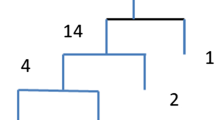Abstract
For a given base γ and a digit set \(\mathcal{B}\) we consider optimal representations of a number x, as defined by Dajani et al. [3]. For a non-integer negative base γ=−β<−1 and the digit set \(\mathcal{A}_{\beta}:= \{0,1,\dots,\lceil\beta\rceil-1\}\) we derive the transformation which generates the optimal representation, if it exists. We show that – unlike the case of negative integer base – almost no x has an optimal representation. For a positive base γ=β>1 and the alphabet \(\mathcal{A}_{\beta}\) we provide an alternative proof of statements obtained by Dajani et al.
Similar content being viewed by others
References
S. Akiyama and K. Scheicher, Symmetric shift radix systems and finite expansions, Math. Pannonica, 18 (2007), 101–124.
J. Bernat, Symmetrized β-integers, Theor. Comput. Sci., 391 (2008), 164–177.
K. Dajani, M. de Vries, V. Komornik and P. Loreti, Optimal expansions in non-integer bases, Proc. Amer. Math. Soc., 140 (2012), 437–447.
M. Edson, Calculating the number of representations and the Garsia entropy in linear numeration systems, Monatsh. Math., 169 (2013), 161–185.
P. Erdős, I. Joó and V. Komornik, Characterization of the unique expansions \(1=\sum_{i=1}^{\infty}q^{-n_{i}}\) and related problems, Bull. Soc. Math. France, 118 (1990), 377–390.
C. Frougny, Confluent linear numeration systems, Theor. Comp. Sci., 106 (1992), 183–219.
C. Frougny, Z. Masáková and E. Pelantová, Complexity of infinite words associated with beta-expansions, RAIRO Theor. Inf. and Appl., 38 (2004), 162–184.
D. Garth and K. G. Hare, Comments on the spectra of Pisot numbers, J. Number Theory, 121 (2006), 187–203.
T.-Y. Li and J. A. Yorke, Ergodic transformations from an interval into itself, Trans. Amer. Math. Soc., 235 (1978), 183–192.
W. Parry, On the β-expansions of real numbers, Acta Math. Acad. Sci. Hungar., 11 (1960), 401–416.
M. Pedicini, Greedy expansions and sets with deleted digits, Theor. Comp. Sci., 332 (2005), 313–336.
A. Rényi, Representations for real numbers and their ergodic properties, Acta Math. Acad. Sci. Hungar., 8 (1957), 477–493.
N. Sidorov, Almost every number has a continuum of beta-expansions, Amer. Math. Monthly, 110 (2003), 838–842.
Author information
Authors and Affiliations
Corresponding author
Additional information
Corresponding author.
Rights and permissions
About this article
Cite this article
Masáková, Z., Pelantová, E. Optimal number representations in negative base. Acta Math Hung 140, 329–340 (2013). https://doi.org/10.1007/s10474-013-0336-6
Received:
Revised:
Accepted:
Published:
Issue Date:
DOI: https://doi.org/10.1007/s10474-013-0336-6



